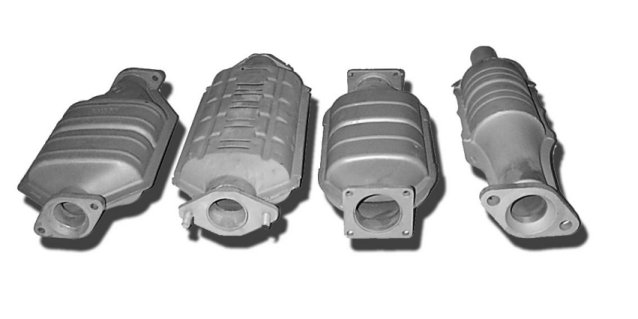Solutions to the problem:
Despite the undisputed potential and importance of gasoline and other fossil fuels the consequences that they can have on the environment and the fact that they are a finite source cannot be ignored. Huge amounts of money have been invested by governments in order to research possible other renewable and non polluting sources of energy and quotas for utilisation of these renewable sources have been set for the future. Much of the research is carried out by the petrochemical companies themselves as well as car manufacturers.
However, whilst crude oil is still available and hence gasoline, efforts can be made in order to make theses fossil fuels more environmentally friendly as well as decrease their consumption by improving their performance.
One particular way is to remove many of the harmful products of combustion by the use of a catalytic converter:
![]() Catalytic converters:
Catalytic converters:

These have recently become standard on all new cars' exhaust systems, with a surface area that can amount to several football pitches, these catalytic converters are effective (at a temperature of 200°C) at reducing the levels of toxic gases produced by the combustion process.
The catalyst typically consists of an alloy of platinum and rhodium which can carry out the following three reactions:
It is possible to see that overall, CO, NO and CxHx are converted to relatively harmless N2 CO2 and H2O
Since there are three reactions occurring at the same time, modern converters are called 'three-way' converters. The addition of lead removes the catalysing capability and effectively 'poisons' the converter, therefore, all systems with catalytic converters must be run with unleaded fuel.
 A
cross section through a catalytic converter illustrating the large surface area.
A
cross section through a catalytic converter illustrating the large surface area.
Picture courtesy of HowStuffWorks.INC.
![]() Control
of quantity of air mixed with fuel:
Control
of quantity of air mixed with fuel:
The quantity of air mixed with the vaporised fuel in the carburettor or fuel-injection system can determine the quantity of carbon monoxide and other exhaust emissions. The amount of air that is exactly enough to combine with the fuel without leaving any left over is called the 'stoichiometric' quantity, on cold winter mornings, engines may require 'choking' which uses an excess of fuel and produces much greater quantities of CO and unburnt hydrocarbons. A 'lean' mixture has an excess of air and produces much lower quantities of polluting gases, for this reason, car manufacturers are producing 'lean burn' engines to meet the demands for reduced emissions.
![]() Recent
developments:
Recent
developments:
There are a number of alternative energy resources that have been around for a while now including wind, solar and hydrothermal energy, however, the problem with these sources is that they are either inefficient or unreliable. However, there has been a recent development in the utilisation of fuel cells in cars. A fuel cell consists of an electrolyte which converts hydrogen and oxygen gas to water and in turn uses this chemical reaction to produce a direct electrical current which can be used to power electrical motors.
 This is a prototype fuel-cell car.
This is a prototype fuel-cell car.
Photo courtesy
Ballard Power Systems
The current problem with fuel cells however, is that hydrogen is difficult to store and distribute, in addition, there are very few hydrogen filling stations at present although this should change should the technology progress further.